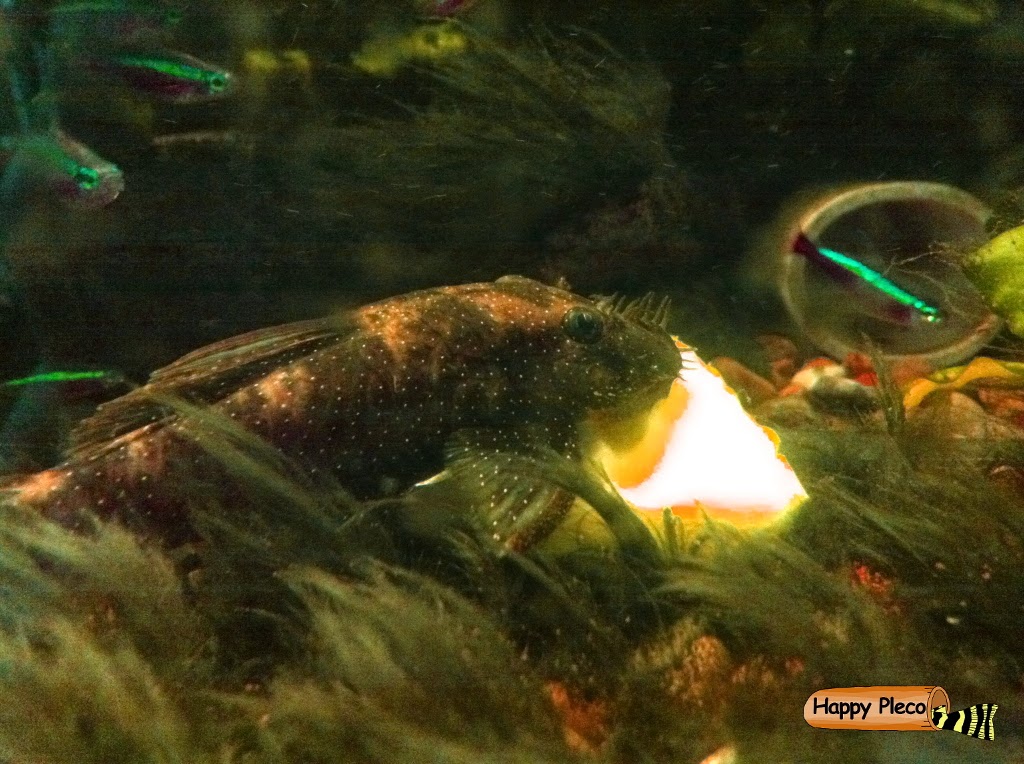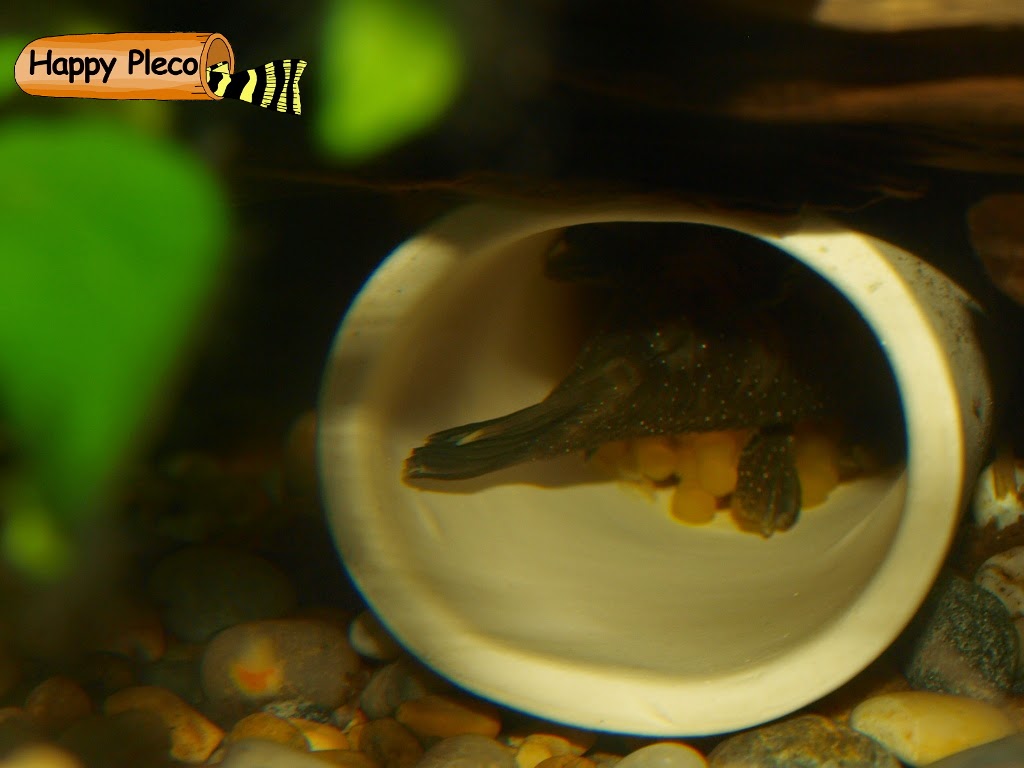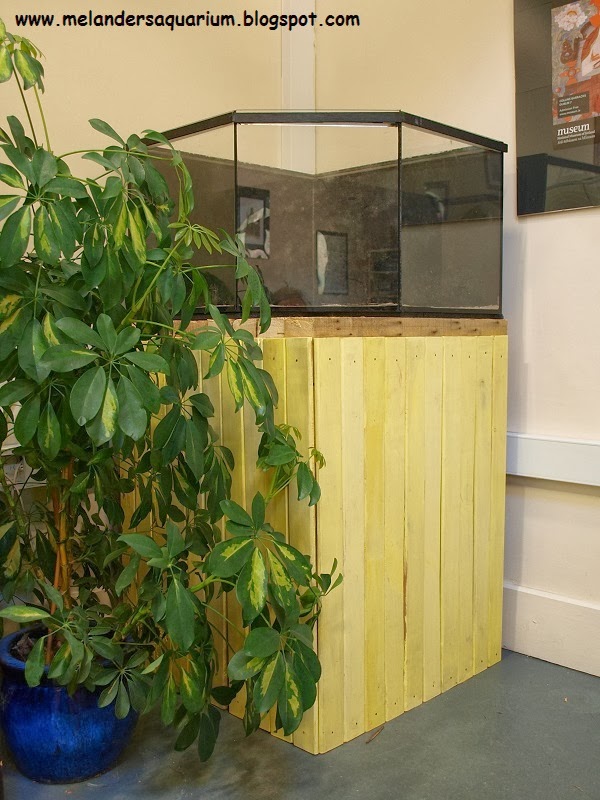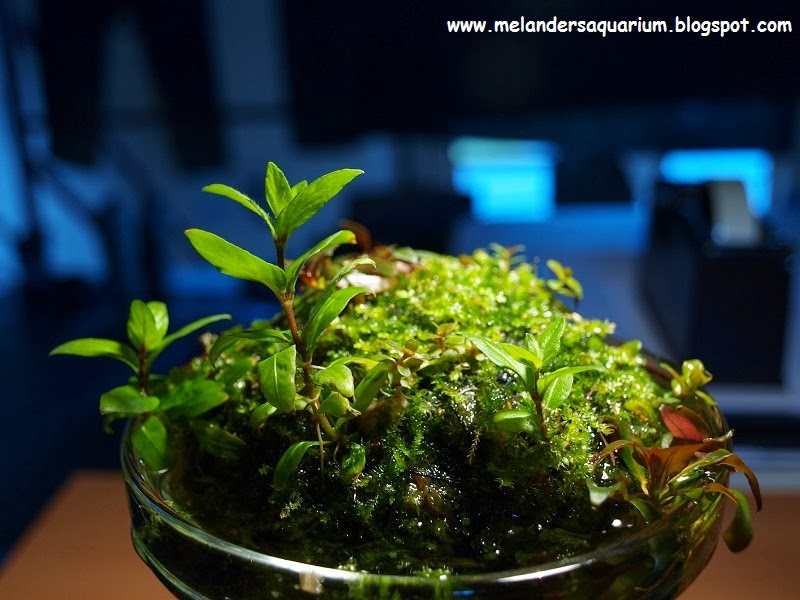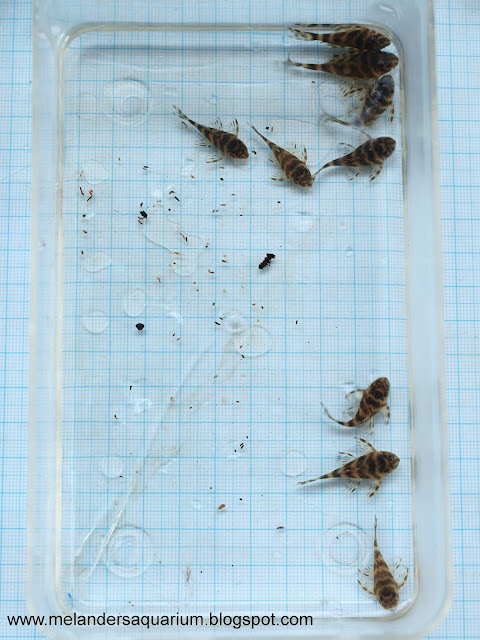Sunday 9 November 2014
Corydoras concolor, breeding tank
This is an old favourite of mine.
The tank is not designed for maximum production of Corydoras eggs but rather to be functional and nice to look at, at the same time. I think it's a very good example of how a breeding tank does not have to be bland and boring.
The 72 litre tank runs by a single powerhead with an attached sponge and a 50w Eheim heater. The heater might be the only thing I would have changed if I was reworking this tank. A less visible location would have made the tank look even better.
These are wild caught Corydoras concolor and it took some time before the first spawn occurred but after that the fish spawned regularly usually after water changes had been performed.
The fish are kept at around 24 degrees Celsius, pH of 6.5 and in very soft water. The interior of twigs, plants and moss, especially at higher locations provide perfect spawning material for these fish.
In this tank I do nothing when it comes to rearing the eggs/fry as I am happy with a few young additions to the group. Fry survival could however easily be increased by providing additional hiding spots for the fry such as clay piper, moss etc.. The fishkeeper could also easily remove the spawning material after each spawn and choose to rear the young in a separate tank.
Again this is not something for the fishkeeper that wants to produce large amounts of young but it's suitable for people that want to watch breeding behaviour in a nice setting.
I am also of the opinion that this kind of tank lead to quality fry as the young has to compete for food and survive on their own which naturally culls the weak.
Happy Fishkeeping!
Friday 26 September 2014
Short update, away from the fish & new links
This has been awhile, the main reason is that I am currently away from my fish and don't really know what is going on, apart from that they are doing well.
The only fish close to me now are my precious Ancistrus sp., plenty of tetras and a two pairs of Angelfish. Both the Angels and the Ancistrus are spawning but in a community setup I fear that that very few fry will survive.
I have also added two new links to the site, these are two excellent sites that I have used many times for information so I highly recommend having a look!
Aquafarmen - very interesting Norwegian breeding projects
wildguppies.com - anything you need to know about wild guppies
Melander
Labels:
ancistrus,
aquafarmen,
guppies,
l180,
links,
wild,
wildguppies
Tuesday 2 September 2014
Ancistrus sp. first spawn
I have had these fish since they were juveniles, for a good few years now and was lucky enough to get one male and two females.
I am delighted that they now have spawned and am looking forward to the little ones hatching, the male has so far been an excellent first time dad:)
The fish has been kept in pH7.5 and dH of around 3, there was no trigger noticed.
The fry will be left to fend for themselves in this community tank, I will keep you posted on their development.
I am delighted that they now have spawned and am looking forward to the little ones hatching, the male has so far been an excellent first time dad:)
The fish has been kept in pH7.5 and dH of around 3, there was no trigger noticed.
The fry will be left to fend for themselves in this community tank, I will keep you posted on their development.
Saturday 31 May 2014
Solution to Easier Waterchanges
We all know the backbreaking and time consuming way of doing waterchanges the traditional way. We still do it as it's part of the hobby and we love our fishes.
There are alternatives though, some people use automated pumps, and even automated water change systems. It's also possible to run many tanks connected to each other and hence only having to change the water in one spot. Another method that I have used my self is to have a spare tank above the rest filled with matured water, in a rack this can quite easily be transfered to lower tanks when doing waterchanges.
Our Danish inventor friend Rene Bannerskjold has come up with a brilliant yet simple DIY solution and was kind enough to send over these pictures.
This is probably what most of us do, it involves alot of carrying and is also time consuming:
To start of, Rene has modified the hose using a fine net so that no fry or smaller fish will be sucked out:
The water container is here replaced by a drain:
The drain is running out trough the back door, this is a very effectiv eand simple solution that most people can use and modify to their needs, fair play Rene!
I would also like to add that this "fish water" is a really good fertilizer for most plants. I always try to use it up either in the garden or for pots and am convinced that I have seen a difference in plant growth.
There are alternatives though, some people use automated pumps, and even automated water change systems. It's also possible to run many tanks connected to each other and hence only having to change the water in one spot. Another method that I have used my self is to have a spare tank above the rest filled with matured water, in a rack this can quite easily be transfered to lower tanks when doing waterchanges.
Our Danish inventor friend Rene Bannerskjold has come up with a brilliant yet simple DIY solution and was kind enough to send over these pictures.
This is probably what most of us do, it involves alot of carrying and is also time consuming:
To start of, Rene has modified the hose using a fine net so that no fry or smaller fish will be sucked out:
The water container is here replaced by a drain:
The drain is running out trough the back door, this is a very effectiv eand simple solution that most people can use and modify to their needs, fair play Rene!
I would also like to add that this "fish water" is a really good fertilizer for most plants. I always try to use it up either in the garden or for pots and am convinced that I have seen a difference in plant growth.
Sunday 25 May 2014
Aquarium Rack, Danish Improvements:)
I think
this is so good, I got help building my rack from Bart of Rainbow Aquatics and
now Rene has improved the design even further, maybe someone will take inspiration from Rene's version now (I know I will:)).
This
version features higher openings above each tank to allow easier access, led
lights and also air lines running in tubes to each tank. I might “steal” the
idea with the air lines in the tubes to improve my own rack if I ever dismantle mine. The filtration system in general looks really neat.
Well done
Rene and many thanks for sharing the photographs and letting me post them here!
The end
result looks really good, have a look for yourselves below:
And finally some smashing looking tanks:
Sunday 18 May 2014
Hypancistrus zebra, L046 t-shirt
I have started to design my own t-shirts, this is the first one and it is now available HERE (www.happypleco.tictail.com).
First out is the stunning Zebra Pleco, L046.
Friday 4 April 2014
Thoughts on Quarantine tanks
First of all, always buy strong and healthy looking fish, but remember that even the healthiest looking fish could carry nasty parasites and illnesses. Therefor a quarantine tanks are hugely beneficial for fish-keepers and fish alike and any serious aquarist should have one available.
These setups allow the aquarist to monitor new arrivals for signs of any decease without the risk of an illness spreading in the main system. Should sick be present a quarantine tank allows the hobbyist to treat the individual fish or fishes instead of the whole system. A positive side that seems often be overlooked is the peace and quite a quarantine tank can offer new arrivals that might be stressed after travelling. The same goes for wild fish getting used to new foods and water parameters. For this reason I personally don’t stick to the bare minimum quarantine tanks but rather try to set up an environment that the particular species can feel comfortable in long term. I also try to keep the quarantine tank in a quite spot to minimize stress.
The most common villain I see is flukes, especially in wild fish. There are plenty of remedies for these and the fish usually recovers unless it’s a particularly bad infestation. I try not to treat the fish straight away and leave them to recover for a weak or two before starting any treatments, just to let the fishes settle in and gain strength.
As for quarantine period, 2-4 weeks seems to be a common recommendation. There is no need to rush and I personally prefer to leave the fish for around a month. This decision depends on the fish and where it comes from.
What you need is a suitable sized tank, a heater and a seeded filter as well as suitable decor for the particular species. Light are not important and if you have them they should not be too strong as this might put additional stress on already weak fish.
As my main interest lies in small sized catfish the tank in the photograph above is set up for these types of fish. The tank is 72 litre, 60x40x30cm which allows enough bottom space for small sized plecos. The abundance of caves and wood lets the fish pick and choose hiding spots. The lights are particularly strong in the photo, but I don’t use them at all for the first week or so and then slowly introduce the light.
This tank is permanently stocked with a group of wild guppies which keeps the system alive and healthy; it also features several spare sponge filters in case they are needed to set up a second tank. If needed, the tank can easily be re-arranged to cater for many different types of species used to similar water parameters. With tetras and otos I would usually add a number of plants for instance.
This is how I do it but there are many ways to skin a cat(fish)
Monday 31 March 2014
Nice find in "random" pet shop
I was out driving across the country with work today and made a stop a pet shop in one of the neighboring towns.
The stock was pretty much what to expect from most non specialist shops but I did find one tank with mixed cories. In this tank there was only one individual of each species, some of them quite uncommon.
This is obviously a very strange way of selling Corydoras, I presume the mixed colours might appeal to new fish-keepers. Anyway I was delighted to see this young concolor as It will be a nice addition to my group and was resonably priced. Perhaps I should not encourage shops to sell cories this way but I felt sorry for the little guy.
This just shows that it’s always worth checking out the more standard pet shops as you never know what could lurk in the tanks.
Always be careful and quarantine your new fish though. This little lad will be in quarantine for a good few weeks.
Thursday 6 March 2014
Corydoras mystery fry
These two came out with a water change today, they are either Corydoras concolor or habrosus. I have not bred either before so it's good either way.
Does anyone know which species they are?
Saturday 1 March 2014
Power Cut, a Fishkeepers Nightmare
As some of you might now we had a 30 hour power cut here a couple of weeks ago. It came at a really bad time in that I was in the process of moving and hence had tanks at two different locations.
I was not
prepared enough but some of the preparations I had made proved vital to my
fishes survival. The losses that I suffered all came from one single tank which
was on the small size (70 liters) and not insulated.
The losses were of younger
animals of Hypancistrus debilittera, L129. The adults suffered too and in the
end I evacuated these animals to a larger tank, It is certain that these
animals would have died too if they would not have been moved.
Unfortunately
I have heard from friends who lost far more fish than me during this cut.
What
worked?
Oxygenation:
I was lucky enough to get my hands on a number of battery driven air pumps and
these proved absolutely vital to the health of my fish. The oxygenated water
seems to also have kept the bacteria alive in my filters (all sponge). My water
tests have all come back good since the event thanks to the air pumps and the
sponges that were floating in the oxygenated water.
Insulation:
One of my tanks was insulated with a layer of Styrofoam and there was a very
clear difference in the temperature between this tank and the others. Obviously
other factors matter too such as size of the tanks but the difference was clear
enough to point to the insulation. In the future most of my tanks will be
insulated.
Improvements?
If this
power cut of 30 hours would have lasted longer, there is no doubt that I would
have lost more fish therefor I will need to improve my chances should this
happen again.
Many fish keepers keep a spare generator at hand and this seems
like a very good long term solution. Unfortunately due to the location this is
not an option for me. I have been looking at various electrical backup
solutions and I will update this post when I have done more research.
As I am
satisfied with how the battery driven air pumps worked my main concern is the
temperature. Apart from covering all tanks with insulation, have spare duvets
ready to cover the tanks I have been suggested to use various heat packs that
can be activated at the time of a power cut and suspended into the tank.
Another
option is to keep a few large tanks that are well insulated; in an emergency
fish from smaller tanks can be temporarily transfers to the larger prepared
tanks which will hold the temperature far longer than the smaller ones.
These
solutions are however only fine if the owner is at home at the time of the
power cut; it’s a different story if the owner is away during the event in
which case an emergency power generator would be more beneficial.
I would be interested in hearing from other fish keepers with experience in this matter.
Labels:
aquarium,
battery,
cut,
Electrical,
emergency,
fish,
fishkeeper,
generator,
power,
solution,
tank
Wednesday 19 February 2014
DIY: Simple tank / aquarium stand
For various reasons I needed a new stand for one of my tanks, and I needed it fast so this is what I (google) came up with.
It's as simple as it gets, no router needed and it takes no time to put together.
All that is needed is some timber (I used 5cm x 7,5cm beams), a hand saw, measureing tape and plenty of skrews.
The idea is that all the weight is held by the wood, the skrews are just holding the stand together not supporting any weight.
All the wood is recycled and there are only straight cuts done with a hand saw, the legs are probably a bit overkill but they won’t be seen anyway.
At one point I thought about putting another horizontal piece of wood in between the legs for stability but there simply was no need for it.
The skeleton of the stand was covered with thin boards from an old Ikea shelf. If you wanted to you could use the lower part as a shelf for storing an external filter, tools or even a second tank/sump.
Now I'll only need to cover up the bits just below the tank, nearly there.
Andreas
It's as simple as it gets, no router needed and it takes no time to put together.
All that is needed is some timber (I used 5cm x 7,5cm beams), a hand saw, measureing tape and plenty of skrews.
The idea is that all the weight is held by the wood, the skrews are just holding the stand together not supporting any weight.
All the wood is recycled and there are only straight cuts done with a hand saw, the legs are probably a bit overkill but they won’t be seen anyway.
At one point I thought about putting another horizontal piece of wood in between the legs for stability but there simply was no need for it.
The skeleton of the stand was covered with thin boards from an old Ikea shelf. If you wanted to you could use the lower part as a shelf for storing an external filter, tools or even a second tank/sump.
Now I'll only need to cover up the bits just below the tank, nearly there.
Andreas
Tuesday 4 February 2014
Friday 24 January 2014
Wabi-kusa!
Just wanted to share this photo of my new Wabi-kusa from Artane Aquatics, It's now sitting on my desk:
I'll update the progress with this one!
I'll update the progress with this one!
Wednesday 15 January 2014
Hypancistrus debilittera, L129; fry development
I just fished out these little lads from their parent’s tank. They are from one of my first spawns of Hypancistrus debilittera, L129 and I believe that I managed to catch roughly two thirds from that batch.
It is very important for the growth and well-being of young plecos that they are not kept in too crowded conditions. Even more so when several batches share the tank as the smaller ones will have a very tough time competing for food and hiding spots against their larger siblings.
These fish were moved so that their younger siblings can get a chance to grow properly and become strong little fishes.They have now moved to a 72 litre tank with strong filtration and plenty of hiding spots.
Labels:
breeding,
debilittera,
fry,
grow,
hypancistrus,
juvenile,
l129,
out,
spawn,
tank
Subscribe to:
Posts (Atom)


